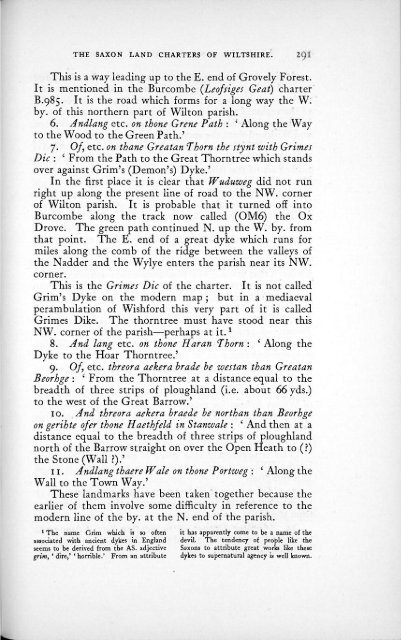It must be understood by all those who read these charters that this ...
It must be understood by all those who read these charters that this ...
It must be understood by all those who read these charters that this ...
Create successful ePaper yourself
Turn your PDF publications into a flip-book with our unique Google optimized e-Paper software.
THE SAXON LAND CHARTERS OF WILTSHIRE. I ~J\<br />
This is a way leading up to the E. end of Grovely Forest.<br />
<strong>It</strong> is mentioned in the Burcom<strong>be</strong> (Leofsiges Geat) charter<br />
B.985. <strong>It</strong> is the road which forms for a long way the W:<br />
<strong>by</strong>. of <strong>this</strong> northern part of Wilton parish.<br />
6. Andlang etc. on thone Grene Path : ' Along the Way<br />
to the Wood to the Green Path.'<br />
7. Of, etc. on thane Greatan Thorn the stynt with Grimes<br />
Die : ' From the Path to the Great Thorntree which stands<br />
over against Grim's (Demon's) Dyke.'<br />
In the first place it is clear <strong>that</strong> Wuduzveg did not run<br />
right up along the present line of road to the NW. corner<br />
of Wilton parish. <strong>It</strong> is probable <strong>that</strong> it turned off into<br />
Burcom<strong>be</strong> along the track now c<strong>all</strong>ed (OM6) the Ox<br />
Drove. The green path continued N. up the W. <strong>by</strong>. from<br />
<strong>that</strong> point. The E. end of a great dyke which runs for<br />
miles along the comb of the ridge <strong>be</strong>tween the v<strong>all</strong>eys of<br />
the Nadder and the Wylye enters the parish near its NW.<br />
corner.<br />
This is the Grimes Die of the charter. <strong>It</strong> is not c<strong>all</strong>ed<br />
Grim's Dyke on the modern map ; but in a mediaeval<br />
perambulation of Wishford <strong>this</strong> very part of it is c<strong>all</strong>ed<br />
Grimes Dike. The thorntree <strong>must</strong> have stood near <strong>this</strong><br />
NW. corner of the parish—perhaps at it. 1<br />
8. And lang etc. on thone Haran Thorn : ' Along the<br />
Dyke to the Hoar Thorntree.'<br />
9. Of, etc. threora aekera brade <strong>be</strong> westan than Greatan<br />
Beorhge : ' From the Thorntree at a distance equal to the<br />
b<strong>read</strong>th of three strips of ploughland (i.e. about 66 yds.)<br />
to the west of the Great Barrow.'<br />
10. And threora aekera braede <strong>be</strong> northan than Beorhge<br />
on gerihte ofer thone Haethfeld in Stanwale : ' And then at a<br />
distance equal to the b<strong>read</strong>th of three strips of ploughland<br />
north of the Barrow straight on over the Open Heath to (?)<br />
the Stone (W<strong>all</strong> ?).'<br />
11. Andlang thaere Wale on thone Portweg : ' Along the<br />
W<strong>all</strong> to the Town Way.'<br />
These landmarks have <strong>be</strong>en taken together <strong>be</strong>cause the<br />
earlier of them involve some difficulty in reference to the<br />
modern line of the <strong>by</strong>. at the N. end of the parish.<br />
1 The name Grim which is so often it has apparently come to <strong>be</strong> a name of the<br />
associated with ancient dykes in England devil. The tendency of people like the<br />
seems to <strong>be</strong> derived from the AS. adjective Saxons to attribute great works like <strong>these</strong><br />
grim, ' dire/ ' horrible.' From an attribute dykes to supernatural agency is well known.
















